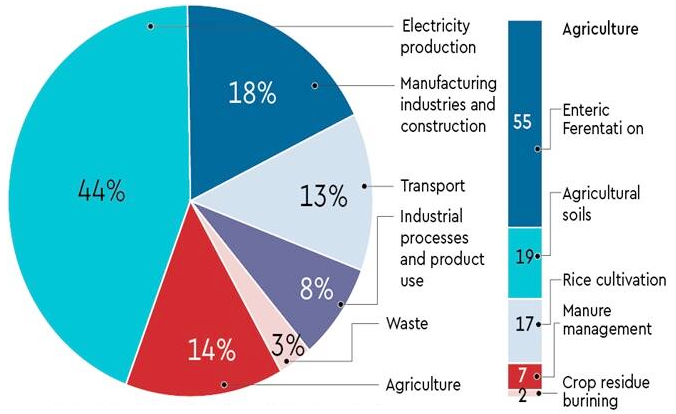Agriculture and Environment | 11 Oct 2021
This article is based upon “A Carbon Policy for the Farm” which was published in the Indian Express on 11/10/2021. It talks about India’s contribution to climate change and how it can prevent further damage by bringing a change in its agricultural regime.
The Sixth Assessment Report by the Intergovernmental Panel on Climate Change (IPCC) has issued a “code red” to humanity declaring 1.5°C warming of the planet as inevitable.
Although environmental health is being given importance globally, the pace of recovery is not as fast as the pace of degradation.
In India’s context, the agriculture and allied sector is the third largest emitter of greenhouse gas after energy and manufacturing sectors.
Being extensively dependent on the sector, India needs to bring certain changes in its agriculture regime and introduce carbon-efficient methods of farming and livestock management.
India: Climate Change and Agriculture
- India’s Position in Air Pollution: As per the World Air Quality Report, 2020, 22 of the 30 most polluted cities in the world are in India and Delhi is the world’s most polluted capital.
- Delhi suffers severely from air pollution during the winter months due to stubble burning in adjoining states.
- The Air Quality Index (AQI) goes beyond 300 on average, with some days going as high as 600 to 800, while the safe limit is below 50.
- Greenhouse Gas Emissions: Globally, India is the third largest emitter of greenhouse gas after China and the US, emitting around 2.6 billion tonnes CO2 equivalent annually.
- However, India’s per capita emissions is just 1.8 tonnes, significantly lower than the world average of 4.4 tonnes per capita.
- India, in its Nationally Determined Contributions (NDCs), has committed to “reduce emission intensity of its GDP by 33 to 35% by 2030 from 2005 level.”
- India’s Sector-wise Emissions: At global level, electricity and heat production, agriculture, forestry and other land use make up 50% of the emissions.
- However, India owes its largest chunk of emissions to the energy sector (44%), manufacturing and construction sector (18%), and agriculture, forestry and land use sectors (14%)
- The remaining is shared by transport, industrial processes and waste sectors.
- However, India owes its largest chunk of emissions to the energy sector (44%), manufacturing and construction sector (18%), and agriculture, forestry and land use sectors (14%)
- Agriculture and Climate Change:
- Total GHG Emissions: The share of agriculture in total emissions has gradually declined from 28% in 1994 to 14% in 2016.
- However, in absolute terms, emissions from agriculture have increased to about 650 Mt CO2 in 2018.
- Emission Classification: Agricultural emissions in India are primarily from the livestock sector (54.6%) and the use of nitrogenous fertilisers (19%).
- Rice cultivation in anaerobic conditions accounts for a major portion of agricultural emissions (17.5%).
- Agricultural soils are the largest single source of nitrous oxide (N2O) emissions.
- N2O emissions from use of nitrogen-fertiliser increased by ~358% during 1980-81 to 2014-15.
- Total GHG Emissions: The share of agriculture in total emissions has gradually declined from 28% in 1994 to 14% in 2016.
Going Towards Carbon-Efficient Agriculture
- Providing Legal Support to the Idea: A carbon policy for agriculture must be framed with the aim to reduce its emissions and reward farmers through carbon credits which should be globally tradable.
- Also, India shall clearly spell out in its policy how it would adjust carbon credits when it sells to polluting industries abroad so that emission reductions are not double counted in India and the country buying carbon credits.
- Changing Feeding Practices: With the world’s largest livestock population (537 million), India needs better feeding practices with smaller numbers of cattle by raising their productivity.
- Promoting Water-Efficient Crops: Besides livestock, rice cultivation is another culprit for methane emissions, especially in the irrigated tracts of north-west India.
- While direct seeded rice and alternative wet and dry practices can reduce the carbon footprint in rice fields, the real solution lies in switching areas from rice to maize or other less water-guzzling crops.
- Also, devising a system for rewarding farmers for switching to corn will make it more profitable than paddy, it can be a win-win situation.
- Promoting Biofuels: Encouraging the use of water-saving crops, such as maize, to produce ethanol, and production of ethanol from non-food feedstock.
- It will help not only reduce India’s huge dependence on crude oil imports but also reduce the carbon footprint.
- Encouraging Fertigation: An alternative for better and efficient fertiliser use would be to promote fertigation (injection of fertilizers) and subsidise soluble fertilisers.
- The government should incentivise and give subsidies on drips for fertigation, switching away from rice to corn or less water-intensive crops, and promoting soluble fertilisers at the same rate of subsidy as granular urea.
- Sustainable Dairy Practices: There is a need to proactively ramp up sustainable dairy practices, which may include:
- Realising the existing potentials for GHG emission reduction through technological and farm best practices interventions and solutions.
- Reducing its demand for resources by better integrating livestock into the circular bio-economy.
- This can be achieved by recycling and recovering nutrients and energy from animal waste.
- Closer integration of livestock with crops and agro-industries at various scales to make use of low value and low-emission biomass.
Conclusion
- Keeping in mind the damages already done to the environment are irreversible, there is a need for a drastic and immediate cut in carbon emissions.
- India being an agriculture-dependent economy, can neither abandon the practice nor undermine the damages that are being caused by it.
- Better carbon-efficient approach is needed to fulfil its Nationally Determined Contributions (NDCs).
|
Drishti Mains Question Discuss the obstacles that the agriculture sector poses in India’s path to fulfilling its Nationally Determined Contributions (NDCs). |

